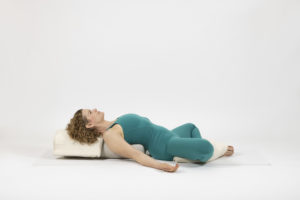
by Leza
Going through “the Pause” is no joke. Night sweats, hot flashes, mood swings, insomnia, and unwelcome anatomical changes are just a few of the things you might experience during this life change. While yoga cannot reverse the march of time, it can alleviate some of the physical discomfort of menopause, bring blood flow and relief to the pelvis, and invite a sense of mental calm and acceptance to the heart. Menopause is a time in life to celebrate ourselves, acknowledge our accomplishments, hard work, and effort in life, and appreciate and honor the fullness of our being.
Before practicing, I find it helpful to set an intention, phrasing it in a positive way like an affirmation. Some examples are: “I accept my body,” “I am relaxed,” or “I am at peace.” Take a moment before starting your practice to place your hand on your heart and ask yourself what is needed in this moment. That can be your intention, so that whenever the mind wanders, you can guide it back to the mental focus you gave yourself at the outset. I recommend practicing the calming breath before doing this short, simple sequence.
1. Calming Breath Practice (Extending the Exhalation), 3-5 minutes.
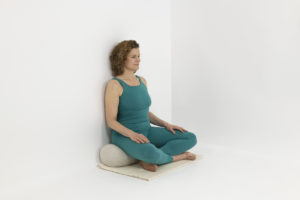
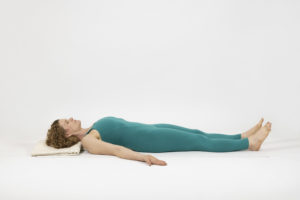
Find a comfortable seated position or lie down. Take a few full breaths, releasing any tension on the exhalations. Then consciously begin to focus on the breath, finding the place it is easiest to access—perhaps your belly or your chest. Don’t try to change anything, just become aware of the natural rhythm. You might notice how the belly and chest rise and expand on the inhalation, and then fall and contract on the exhalation. Notice and observe for a few minutes. As you bring your awareness to the breath, it might naturally begin to slow and deepen. When you’re ready, practice extending the exhalation. You can do this by consciously lengthening the exhalation, making it longer than your inhalation. Practice this for 2-5 minutes, as long as you’re comfortable. You can also practice this breath in the restorative poses that follow, if it feels comfortable to do so. See this excellent article Calming Breath Practice: SOS for Panic Attacks and More by Nina for more detailed instructions on the practice.
2. Reclined Cobbler’s Pose, 5-10 minutes.

The hips have often been called the “storehouse of emotions,” so bringing breath and awareness to the hips and pelvis can allow us to release long-held emotional patterns and blockages. Blocks or rolled up blankets under the knees help support the hips opening with the force of gravity. Breathe gently into your belly and heart, softening on the inhalation and releasing tension on the exhalation.
For more information on how to practice this pose, see Featured Pose: Reclined Cobbler’s Pose.
3. Restorative Wide-Angle Seated Forward Bend (Upavista Konasana), 3-5 minutes.
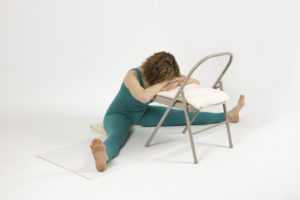
This pose is a wonderful way to bring your awareness inward and calm the mind. It also stretches the lower back, groins, inner thighs, and backs of the legs while releasing tension in the backs of the head, neck, and shoulders.
To set up for the pose, place a folded blanket on the seat of a chair and another one several inches away from the chair legs.
To enter the pose, sit on the edge of the folded blanket in front of the chair and take your legs as wide open as is comfortable. If tight leg muscles make this position uncomfortable, you can try placing a bolster or rolled up blanket under each knee.
Then fold forward from your hip joints, keeping your spine extended. Use the seat of a chair to support your arms and forehead as shown in the photo or, if you’re more flexible, you can place a bolster or folded-up blankets between your legs for support. Breathe into your back body and surrender. Try to keep your neck long and allow your shoulders to release. Notice if there is any tension in your jaw, inviting that to soften.
4. Empress Pose, 5 to 15 minutes.
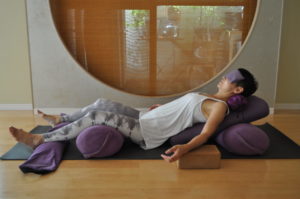
Empress pose gives such a comforting feeling of full support and ease, allowing the body and mind to deeply relax. This supported, restorative version of Savasana releases lower back pain and pelvic discomfort, and opens your chest, shoulders, and heart while gently stretching your spine and calming your nervous system. It also increases blood circulation to the pelvis, abdomen, heart, and lungs. It is calming, soothing, and helps restore emotional imbalance. For this pose, your breath can be natural, as you would breathe in Savasana. I consider this a luxurious variation of Savasana.
See Featured Restorative Pose: Empress Pose for information about how to practice this pose and photos of some variations.
I hope this sequence offers you some relief from discomfort due to menopause. If nothing else, spending time tuning into your body, honoring it, and practicing slow, deep breath is deeply comforting and calming.
For more about Restorative Yoga poses, see Restorative Yoga: The Big Picture.
You can read more about Leza’s writing at www.lezalowitz.com and about her yoga studio and classes at www.sunandmoon.jp.
• Follow Yoga for Healthy Aging on Facebook and follow Nina on Instagram • Order Yoga for Times of Change here and purchase the companion videos here • Order Yoga for Healthy Aging: A Guide to Lifelong Well-Being here.


Leave A Comment